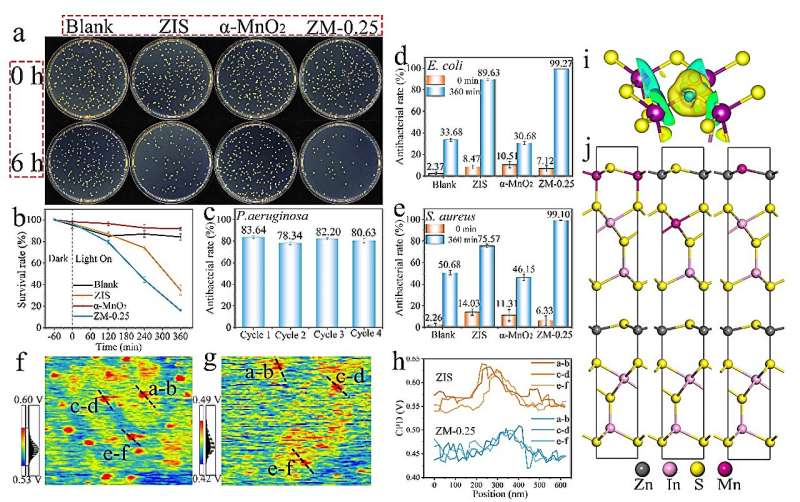 Analysis of the antibacterial performance and mechanism of enhancement of solid-state α-MnO2 decomposition doping in ZIS. Credit: IOCAS
Analysis of the antibacterial performance and mechanism of enhancement of solid-state α-MnO2 decomposition doping in ZIS. Credit: IOCASImagine a world where cleanup is as easy as shining a light! A team of dedicated researchers is making strides toward that dream by enhancing materials that can deactivate harmful bacteria using a simple yet effective approach. Their recent findings offer hope for cleaner ecosystems and healthier living spaces.
Photocatalytic technology has emerged as an innovative way to combat bacteria and biofilm buildup, with its eco-friendly characteristics drawing attention around the globe. However, many single materials used in these processes often struggle due to less-than-ideal efficiency in separating positive and negative charge carriers. That’s where the research led by Professor Zhang Jie at the Institute of Oceanology of the Chinese Academy of Sciences comes in.
The team took a fresh approach by using manganese and sulfur co-doped zinc indium sulfide (ZIS) and combining it with an oxygen vacancy-rich manganese dioxide (α-MnO2). This novel combination is not just clever; it’s effective! Their work, published in the Journal of Materials Chemistry A, reveals how this innovative technique leads to impressive enhancements in photocatalytic antibacterial activity.
By employing a solid-state decomposition method, the researchers were able to create materials that release manganese elements slowly. This ensures that the manganese integrates smoothly into the ZIS lattice, leading to better performance in both degrading harmful substances and mitigating bacterial activities than other conventional methods.
Analyzing their findings through advanced techniques like Kelvin scanning probe microscopy and density functional theory, the researchers discovered another exciting detail: this new method reduces the work function of the material. In simpler terms, this means that the energy needed for photoelectrons to move to the surface is significantly lower, making it easier for these electrons to do their job.
The connection formed between sulfur and manganese plays an essential role as well. It promotes quick movement of the photoelectrons at the surface, while the increased oxygen vacancy content helps to keep photogenerated charge carriers from recombining too quickly. This combination is a trifecta of strategies working together to enhance antibacterial efficacy.
Overall, this innovative solid-state decomposition technique is paving the way for a more effective approach to creating antibacterial materials. It shows us that with the right methods, we can harness the power of nature and technology to improve public health and environmental safety.
More information:
Hui Zhang et al, Improvement of photocatalytic antibacterial action of Mn, Sv-co-doped ZnIn2S4 prepared by a novel Ov-rich α-MnO2 decomposition approach, Journal of Materials Chemistry A (2025). DOI: 10.1039/D5TA01357G
If you would like to see similar science posts like this, click here & share this article with your friends!


